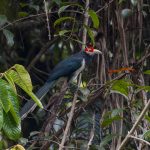
I would say it was just another mundane morning at the treatment ponds in SW Tobago – but this wouldn’t be true no matter how convenient the framing would be to set the stage for this post. Several migratory species were around – I’ll touch on these in a subsequent post – but all was quiet and calm nevertheless.
Ducks and grebes paddled around, Anhingas swam beneath the surface, occasionally appearing with a skewered fish. A Black Skimmer drifted from one end of the pond to the other, oftentimes coming into such proximity that the swishing of its feathers was audible. I had been visiting the ponds for the ducks, but stayed for the general ambience.

An Anhinga tosses her freshly caught breakfast.

Black Skimmer

Two immature Least Grebes approach an adult, asking kindly for a snack.
After about an hour, I noticed an unfamiliar presence: a Spectacled Caiman! These small crocodilians pose no threat to humans, but I had never before seen one in these ponds. Sure enough, I wondered about their presence as there was ample food available – fish and aquatic invertebrates – but hadn’t seen one up until this particular morning.
As the caiman blinked its eyes and lay motionless in the water, it became apparent that I wasn’t the only one surprised by its presence. A Least Grebe began a tentative approach, its bright yellow eyes affixed on the caiman. Slowly, it got closer. And closer. Was it going to waltz into becoming breakfast?

Maybe the grebe had never seen a Spectacled Caiman before? Perhaps the bird was trying to get a closer view, so as to reference the images of possible threats it learned as a young bird? Oh, how the things you learn in school very rapidly vaporize once adulthood sets in…
My assessment of the situation was that the grebe made a very ideal-sized meal for the caiman. It seemed as if it was almost the perfect size. As I was pondering this, making the calculations of caiman jaw size versus grebe roundness – the bird suddenly panicked, as humans do when they bump into something unfamiliar in the dark.

As comical as it was, the caiman didn’t seem too amused by the whole thing, and began to lazily swim off toward the other end of the pond. Which attracted more attention from the twenty-or-so Least Grebes in the pond. Adults and juveniles all surrounded the beast, while keeping a respectable distance.

Eventually the caiman disappeared and equilibrium was restored. I spoke with some other birders who also remarked on seeing the caiman for the first time. Did I witness the initiation of the caiman into life in this treatment pond? I’ve seen the species mentioned here happily coexisting in other places, so I didn’t expect curiosity from either party. But nature continues to emphasize the point that species are not individuals.













Leave a Comment